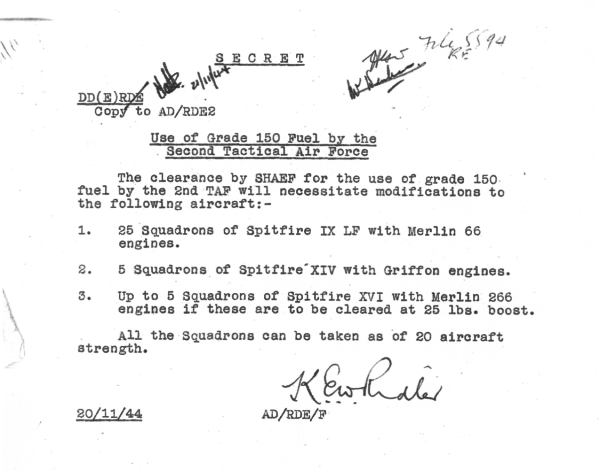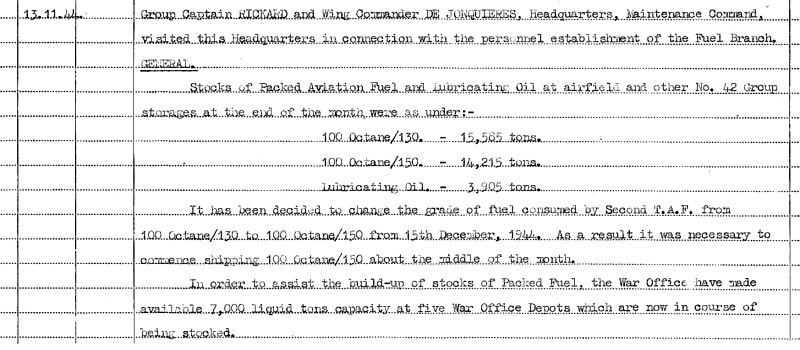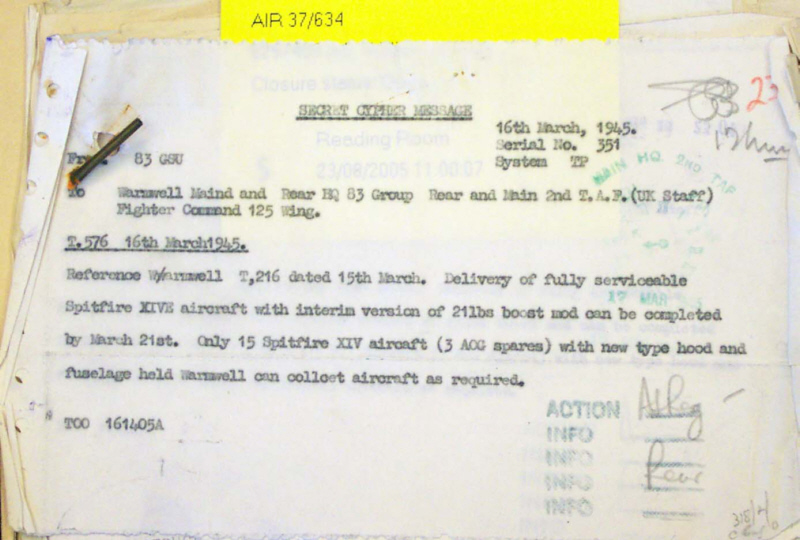Hello Bronk: The following is culled from various pages at
WWIIaircraftperformance.org, in particular
Spitfire IX Performance Testing,
Spitfire XIV Performance Testing,
Spitfire Mk XIV versus Me 109 G/K, A Performance Comparison and
100/150 Grade Fuel.
During 1942 and 1943 the British started testing fuels that allowed for higher engine powers than were possible using the standard fuel of the time. Testing of a Spitfire IX by Rolls Royce, Hucknall in October 1943 determined:
- The increase of boost pressure to 25 lbs/sq.inch provides a considerable improvement in the low altitude performance of the Spitfire IX aircraft, the necessary modifications to achieve this being comparatively simple.(1)
The same aircraft was tested by the Aircraft and Armament Experimental Establishment (A.& A.E.E.), Boscombe Down November 1943, the conclusion being:
- An increase of about 950 ft/min in rate of climb and about 30 mph in all-out level speed is achieved by the increase of boost from +18 lb/sq.in. to +25 lb/sq.in.(2)
Following successful testing, the Spitfire IX's Merlin 66 was cleared in March 1944 to use +25 lbs boost, obtainable with 150 grade fuel.
(3) In early May, No. 1 and No. 165 Squadrons comprising the Predannack Wing, were the first units to convert their Spitfires to +25 lbs boost and employ 150 grade fuel on operations.
(4) (5) Air Defense Great Britain (A.D.G.B.) shared a report, dated 16th June 1944 with A.E.A.F. summarizing the RAF's experience with using 150 Grade Fuel in Merlin 66 engines.
(6) All pilots reported most favorably on the value of the high boost pressures obtainable with 150 Grade Fuel, however, Technical Staff felt that before the fuel was introduced on a large scale that the causes of backfires must be established and that at least 12 engines should complete 200 hours each. The backfire issues were resolved by August.
(7) The increased performance obtained with 150 Grade Fuel was put to good use by Mustangs, Tempests and Spitfires in intercepting Buzz Bombs launched against Britain beginning mid June. Performance increases at sea level for the Spitfires were as follows: Spitfire IX - 335 mph increased to 358 mph; Spitfire XIV – 359 mph increased to 366-370 mph.
On 18 September 1944 A.D.G.B. very positively summarized the experience gained to date using 100/150 grade fuel.
(8) However, due primarily to logistical difficulties, such as the interchange of squadrons between A.D.G.B. and 2nd T.A.F., it was decided that UK based fighter squadrons should revert to the use of 130 grade fuel. Its unclear as to the degree to which this decision was carried out as of November 1944 Fighter Command was apparently still using 2,000 tons of 150 grade fuel per month.
(9) During November 1944 S.H.A.E.F cleared 100/150 grade fuel for use by the Second Tactical Air Force:

It was decided that the Second Tactical Air force would change over from 100/130 grade fuel to 100/150 grade fuel from the 15th December 1944.

The shipping of fuel from Antwerp started on 2 January, 1945.
(10)100/150 grade fuel was introduced into Spitfires of 83 and 84 Groups during January 1945:

New Spitfire XIV replacements were delivered with their Griffon engines set up for +21 boost:

Some Griffon engines were cleared for +25 lbs boost before war’s end.
(11)1.
Spitfire J.L.165 with Merlin 66 at 25 Lbs. Boost Pressure, Dor/Chr/RLS.1/MNH. 8.10.43 2.
Spitfire IX JL.165 (Merlin 66) Trials at +25 lb/sq.inch boost with Rotol 4 blade propeller. A.& A.E.E. ref: CTO/AS.56/80. 3.
Approval of 25 lbs Combat Boost on Merlin 66. 10 March, 1944. 4.
1 Squadron Operations Record Book5.
165 Squadron Operations Record Book6.
Interim Report – Service Trials of Merlin 66 Engines operating at + 25lbs. Boost Pressure. 16 June, 1944. 7.
Backfire trouble resulting from use of 150 grade fuel. 12 August, 19448.
Use of 150 Grade Fuel, HQ ADGB, ADGB/S.37041/CTO. 18th September 1944. 9.
Grade 100/150 Fuel, J.H Houghton Colonel A.C., Director of Supply, 23 November 1944.10.
No. 424 Aviation Fuel and Ammunition Park, 2nd T.A.F. ORB, January, 1945.11.
Directorate of Engine Development, 28th March, 1945Misc.:
Operation of Spitfire IX LF with 25 lbs/sq.in. BoostSpeed comparison: +18 vrs +25 lbs/sq.in. boost SL speeds, Crossbow Fighters 11 July 1944
Merlin 66 HP ChartMerlin 66 development - engine performance projected and accomplished in 1943 (from Rolls-Royce)
Spitfire performance projected and achieved by Merlin 66 engine development in 1943 (from Rolls-Royce)
Throttle Quadrant Adjustment (25 Lb. BoostIan Ponsford who was credited with 7 enemy aircraft destroyed, 1 probable and three damaged whilst flying Spitfire XIV's with 130 Squadron recalled:
The Spitfire XIV was the most marvellous aeroplane at that time and I consider it to have been the best operational fighter of them all as it could out-climb virtually anything. The earlier Merlin-Spitifre may have had a slight edge when it came to turning performance but the Mark XIV was certainly better in this respect than the opposition we were faced with. The only thing it couldn't do was keep up with the FW 190D in a dive. It could be a bit tricky on take off if one opened the throttle too quickly as you just couldn't hold it staight because the torque was so great from the enormous power developed from the Griffon engine. One big advantage that we had over the Germans was that we ran our aircraft on advanced fuels which gave us more power. The 150 octane fuel that we used was strange looking stuff as it was bright green and had an awful smell - it had to be heavily leaded to cope with the extra compression of the engine.
A special thanks to Neil Sterling for all his excellent work on this subject.